|
Welcome to beautiful
Livatho
A picturesque region that stretches along the south-western
coastline of the largest and most beautiful island of the Ionian
Sea, Kefalonia.
Each village has its history, each corner its memories.
Tradition and history exist alongside modern development, and lend
the region of Livatho a distinct character with a rich cultural
tradition. |
|
View photos of
the region
|
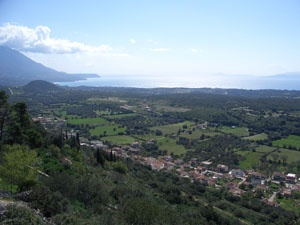 |
Livatho, with its stunning
sandy beaches,its meadows and mountains, is a region that attracts
many visitors, who are amply rewarded for their choice by the
natural beauty, as well as the high quality of the tourist
facilities available.
Sights-worth-seeing in our Municipality are the archaeological
sights, the traditional villages, some remarkable church buildings,
along with the modern monuments.
The municipality of Livatho as a region with a rich cultural
tradition and boasts an active, high-quality, varied programme of
cultural events.
|
|
THE GEOGRAPHY OF THE REGION
To the west,Livatho borders on the Municipality of Argostoli, to the
north the Municipalities of Argostoli and Omala, to the east the
municipality of Elios-Pronni, while the southern part is washed by
the Ionian Sea.
The mountain of Ainos, which constitutes a natural border with the
north-east of the island, ensures an abundant supply of fresh water
and very fertile soil.
Livatho's rich natural features make it unforgettable.
The Ano Livatho area has both mountains and sea shores, with its
villages streching from the southern slopes of Ainos, a mountain
famed for its black Kefalonian Fir trees, down to the Ionian sea.
In Kato Livatho, the natural environment co-exists peacefully with
the local inhabitants.
|
|
SIGHTS |
|
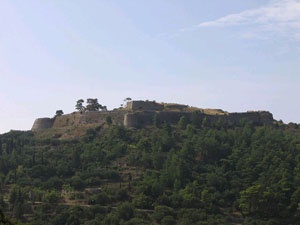 |
ΚThe Castle of Saint
George: Military and administrative area of the island up to 1757,
built on the well-fortified top of the highest hill in the region
(320m).
The outside walls we can see today- from which the view is
panoramic- were constructed between 1504 and 1534 by the Venetian
engineer Nicholas Tsimaras. He rebuilt the castle walls which had
been destroyed during a recent siege of the then Turkish-occupied
fortress by the Spanish-Venetian forces.
The Castle of Saint George has a long history, the site having been
used as a fortress since ancient times.
The area inside the walls (16.000 sq m) includes ruins of public
buildings, on which restoration work has recently been carried out,
the church of Saint Nicholas, the internal part of three bastions
and many other ruins.
|
|
The castle was the
capital of Kefalonia until 1757 when Argostoli became the new
capital. The earthquakes in 1953 caused a great deal of damage.
Today, there are just a few houses, belonging to families who have
lived next to the castle walls for generations.
Great effort has been made recently to restore the buildings and
monuments damaged by the earthquakes, as well as more general
presentation work in line with the castle'straditional and
archaeological status.
|
|
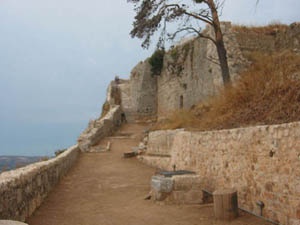
|
ΜThe Castle of Saint George: Military and administrative area of the
island up to 1757, built on the well-fortified top of the highest
hill in the region (320m).
The outside walls we can see today- from which the view is
panoramic- were constructed between 1504 and 1534 by the Venetian
engineer Nicholas Tsimaras. He rebuilt the castle walls which had
been destroyed during a recent siege of the then Turkish-occupied
fortress by the Spanish-Venetian forces.
The Castle of Saint George has a long history, the site having been
used as a fortress since ancient times.
The area inside the walls (16.000 sq m) includes ruins of public
buildings, on which restoration work has recently been carried out,
the church of Saint Nicholas, the internal part of three bastions
and many other ruins.
|
|
|
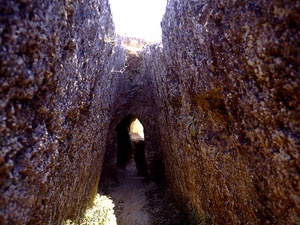 |
Mazarakata: The
excavations of the archaeologist Kavvadias in the first decade of
the 20th century, uncovered vaulted mass graves of the late Mycenean
period, with 84 chamber tombs, part of which had been desecrated.
Prior to that, De Bosset had excavated the site of "Maza-karata"
(1810-1812) and the 55 finds which came to light were donated by him
to a museum in his birthplace, Neauchatel.
|
The Ecclesiastical
Byzantine Museum: Located in the grounds of the Monastery of Saint
Andreas Milapidia.
The museum houses rare exhibits, such as vestments, wood carvings,
wall paintings, embroideries and icons from the 13th to the 19th
century.
The Archaeological Museum in Argostoli boasts a wealth of artefacts
recovered from tombs in the region of Livatho.
Also, the Korgialenios Library in Argostoli houses the private
collection of paintings and other possessions of Fragiskos and
Stephanos Vallianos.
The Monastery of Saint Andreas Milapidia: This ancient Monastery was
rebuilt in 1579 by Neofitos Romanos and Gasparos Migardos.
There was a “girls' boarding school” on the site from 1830 to 1835,
founded by a Mr. and Mrs. Dixon.
The new church of Saint Andreas was rebuilt thanks to donations from
benefactors Mazarakis and Basias.
In the Monastery there are relics of Saint Andreas and the
Ecclesiastical Byzantine Museum can be found in the grounds.
The Monastery of Estavromenos: In 1602 the monastery was given by
the Balsamakis family to their brother, a monk, to set up a commune.
Today, the original icon is housed in the Evaggelistria church in
Pessada, whilst the only existing icon of the Virgin Mary Diotissa
(The Madonna of Vlaherna) can be found in the Monastery of
Estavromenos.
The Monastery of Sissia: The 1953 earthquake completely destroyed
the original monastery, which according to tradition, was founded in
the 13th century by Saint Francis of Assisi.
Both Orthodox and Catholic masses are said separately at the
monastery today.
The icon of the Virgin Mary from the Monastery “The Madonna of
Akathistos” was painted in 1700 by the Icon-painter Stephanos
Tzagarolas.
|
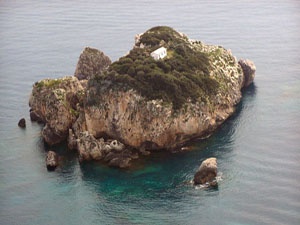 |
Dias island: The Church of
the Virgin Mary Diotissa or Virgin Mary of Vlaherna. The Island of
Dias can be reached by boat from Pessada, and lies only half a mile
from the shore.
One hundred steps lead up to the church, which is 24 m above
sea-level and was built on the ruins of the Temple of Zeus (Dias).
The church hosts a that celebration every year on July 2nd.
|
The Church of the
Evaggelistria, Castro: Located on the same hill as the Castle of St
George, the Church of the Evggelistria is famous for its impressive
bell tower.
In Kourkoumelata you can see a grand neo-classical building, which
acts as a museum and is also "The George and Mary Vergoti Cultural
Centre:.
This is home to several valuable exhibits, as well as various
cultural events for which the region is well-known. Right next door
is the local stadium where both residents and visitors can take
exercise.
|
| |
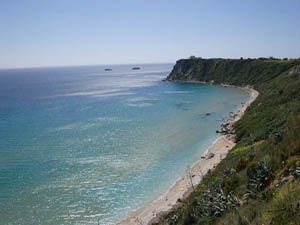 |
BEACHES
Avithos: Considered as the best beach in Kato Livatho, it is a sandy
beach with several good facilities and shallow, crystal-clear waters
and suitable for surfing.
|
|
Saint Pelagia: A small, sheltered harbour between Ai Helis beach and
Ammes beach, with mooring for fishing boats and yachts.
This particular area has connections with the Greek War of
Independence, since boats packed with Kefalonian volunteers sailed
from the harbour to the Peloponnese.
Saint Thomas: A rocky prompntory and sandy beach below the village
of Karavados.
Ai-Helis (Saint Achilleos): A small, picturesque and well-appointed
beach near Svoronata, with good facilities,unusual "black" sand and
delightful walks.
Ammes: A sandy beach near the village of Svoronata, with good
facilities and crystal-clear waters.
Klimatisia: A small, sandy beach below the picturesque village of
Spartia, ideal for swimming and relaxing.
Lithero: A narrow road a short distance from Lourdas leads to a
peaceful beach where the visitor can enjoy a quiet spot for swimming
and sunbathing.
Lourdas: A long beach with both sand and shingle, a stone's throw
from vegetable gardens, olive and orange groves and fringed with
tropical plants.
Paliolinos: Drive through the villages Korianna and Klismata to
discover this small beach at the end of the road.
Trapezaki: Before going down to the long sandy beach, don't forget
to visit the church of the Virgin Mary on the pine-tree-covered
hill, where an old silver icon is housed.
|
|
VILLAGES AND HAMLETS OF LIvATHO
Vlahata: The village is located at the foot of Mount Ainos and has
beautiful views. Admire the village church, Saint Marina, which was
not destroyed by the 1953 earthquake.
Dorizata: A small, quiet village, with lush vegetation. The main
road throough the village was built during the period when the
island was governed by the British and links Krania with the
villages of Ano Livatho. The village was the birthplace of the
distinguished archbishop Gerasimos III (Dorizas).
Kalligata: In the church of the Holly Virgin Mary, built in the 18th
century, you can admire the splendid hand-carved wooden icon-screen
in the baroque style of 1804 and the impressive bell-tower. The
village was the birthplace of the bishop of Kefalonia, and later of
Athens, Germanos Kalligas, and eminent academic Pavlos Kalligas.
Karavados: A small picturesque “Captains' village”, with courtyards
full of flowers, the church of Saints Konstantinos and Eleni, which
has the only solid marble icon-screen on the island. Leaving the
village on your way down to the beach of Saint Thomas, don't forget
to stop at the plane trees and drink the cool spring water.
Keramies: It is possible that the name comes from the old pottery
that used to be there. The village is also home to the remarkable
Russian-style church of Saint Vasilios. The famous ship-owning
families of Vallianos and Lykiardopoulos come from the village.
Kourkoumelata: A real gem of a village, Kourkoumelata is filled with
beautiful buildings, laid out along modern roads, with stylish
gardens. An idyllic environment, Kourkoumelata has been called the
most beautiful village in the Balkans. The original village having
been totally destroyed in the 1953 earthquakes, it was rebuilt with
donations from the ship-owner, George Vergoti, who gave the new
houses to landowners free of charge.
Lakithra: Lord Byron sat in the place that today bears his name
(Byron's Rock) and, gazing at the Ionian sea, composed poetry.
During excavations near the church of Saint Nicholas, four post-Mycenean
chamber tombs were discovered.
Lourdata: a village full of gardens and cottages, lying about half a
kilometre from the enchanting beach of Lourdas. Its abundant
springs, vegetable gardens and groves of trees make the beach unique
in Greece. You must visit the church of Agia Paraskevi (Saint
Friday), a short distance from the square, with tits rare religious
paintings from the 14th century.
Metaxata: For many years the village was the headquarters of the
archbishops of Kefalonia. Lord Byron stayed at the house of Ali
Pasha's doctor, Stravolemis Metaxas, for about four months in 1823.
In 1933 the archaelogist Marinatos discovered three Mycenean chamber
tombs in the area known as "Halikera".
Mousata: Like Vlachata and Simotata, Mousata is One of the villages
of the "Eikosimia" . It is famous for its honey produced from the
nectar from coniferous trees and thyme, its sweet-tasting village
bread,along with the two remaining workshops producing hessian cloth
(used in the old-style olive presses), as well as woven carpets.
Ntomata: in the church of the Virgin Mary Eisodia, with its
marvellous hand-carved wooden icon screen decorated in melted gold
(12.000 gold sovereigns were used), is the coffin of Grigorios V,
which was rescued and brought to Ntomata in 1821 by captain George
Sklavos. on the outskirts of the village there is a very old olive
tree, known locally as “The Olive-tree of chatting”.
Pessada: During the summer, there is a daily ferry from the port to
the island of Zakynthos. In the village itself, visit the Church of
Evaggelistria, dating from the 19th century, with its miraculous
icon of “ The Virgin Mary of Palaioktisti” (from a religious
wall-painting in the original church). You can also see the
extremely beautiful icon from the Monastery of Estavromenos. In
recent research based on the Acts of the Apostles (Chapter 28, verse
1), Pessada has been connected with the shipwreck of apostle Paul.
Poriarata: A Village in Ano Livatho, in the area known as Eikosimia,
built in the shape of an amphitheatre amongst olive trees and
flowers. Above the village there is a huge area of land, known as
“At the Bishop's”, which used to belong to the bishop of Maini,
Jeremiah.
Sarlata: A small, graphic, secluded village, that is ideal for quiet
holidays, the first that you meet as you entre Livatho from the
direction of Argostoli. The first head office of the famous Band of
Livatho. At the central church of the village, at Saint Athanasios,
is buried the legendary captain Fokas.
Svoronata: Admire houses with the traditional Kefalonian
architecture and wrought-iron gates, demonstrating the old craft of
the kefalonian blacksmiths. There is also an imposing belfry at the
church of Saint Nicholas, the patron saint of seamen. Svoronata was
the bithplace of Colonel Svoronos who was on active duty in
Macedonia in 1912.
Simotata: According to an old Lixurian proverb, the village was
always known for its cheese. Another saying goes: “wine from Minies
and cheese from Simotata”.
Spartia-Korianna-Klismata: Three beautiful villages retaining some
of the original homes of thearistocracy and samples of local
architecture. Evangelos Panas, who saw active duty in 1821 in the
Battle of Lala, came fron Spartia. Visit the small private church of
saint Gerasimos in Spartia and admire the elegant 15th century
belfry.
Travliata-Peratata: The Church of the Savior in Travliata, with its
old icon screen and the icon of the Lady of Angels by Amvrosios
Borinis, is well-worth visiting. Both villages are located along the
main road leading to Poros.
τάση
στην πλατανόφυτη ειδυλλιακή περιοχή και να πιείτε «καραβισιάνικο»
δροσερό πηγαίο νερό.
|
|